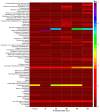Characterisation of Flavour Attributes in Egg White Protein Using HS-GC-IMS Combined with E-Nose and E-Tongue: Effect of High-Voltage Cold Plasma Treatment Time
- PMID: 35163870
- PMCID: PMC8838924
- DOI: 10.3390/molecules27030601
Characterisation of Flavour Attributes in Egg White Protein Using HS-GC-IMS Combined with E-Nose and E-Tongue: Effect of High-Voltage Cold Plasma Treatment Time
Abstract
Egg white protein (EWP) is susceptible to denaturation and coagulation when exposed to high temperatures, adversely affecting its flavour, thereby influencing consumers' decisions. Here, we employ high-voltage cold plasma (HVCP) as a novel nonthermal technique to investigate its influence on the EWP's flavour attributes using E-nose, E-tongue, and headspace gas-chromatography-ion-mobilisation spectrometry (HS-GC-IMS) due to their rapidness and high sensitivity in identifying flavour fingerprints in foods. The EWP was investigated at 0, 60, 120, 180, 240, and 300 s of HVCP treatment time. The results revealed that HVCP significantly influences the odour and taste attributes of the EWP across all treatments, with a more significant influence at 60 and 120 s of HVCP treatment. Principal component analyses of the E-nose and E-tongue clearly distinguish the odour and taste sensors' responses. The HS-GC-IMS analysis identified 65 volatile compounds across the treatments. The volatile compounds' concentrations increased as the HVCP treatment time was increased from 0 to 300 s. The significant compounds contributing to EWP characterisation include heptanal, ethylbenzene, ethanol, acetic acid, nonanal, heptacosane, 5-octadecanal, decanal, p-xylene, and octanal. Thus, this study shows that HVCP could be utilised to modify and improve the EWP flavour attributes.
Keywords: E-nose; E-tongue; PCA; PLS-DA; egg white protein; flavour; high-voltage cold plasma; volatile compounds.
Conflict of interest statement
The authors declare no conflict of interest.
Figures







Similar articles
-
Flavor profile analysis of grilled lamb seasoned with classic salt, chili pepper, and cumin (Cuminum cyminum) through HS-SPME-GC-MS, HS-GC-IMS, E-nose techniques, and sensory evaluation on Sonit sheep.Food Chem. 2024 Oct 1;454:139514. doi: 10.1016/j.foodchem.2024.139514. Epub 2024 Apr 29. Food Chem. 2024. PMID: 38797107
-
Variations of volatile flavour compounds in finger citron (Citrus medica L. var. sarcodactylis) pickling process revealed by E-nose, HS-SPME-GC-MS and HS-GC-IMS.Food Res Int. 2020 Dec;138(Pt A):109717. doi: 10.1016/j.foodres.2020.109717. Epub 2020 Sep 24. Food Res Int. 2020. PMID: 33292962
-
Evaluation of flavor characteristics in Chinese wheat flour paste using electronic-nose, electronic-tongue, and headspace-gas chromatography-ion mobility spectrometry at different fermentation stages.J Sci Food Agric. 2025 Mar 15;105(4):2454-2465. doi: 10.1002/jsfa.14017. Epub 2024 Nov 15. J Sci Food Agric. 2025. PMID: 39548696
-
[Recent advances in the application of headspace gas chromatography-mass spectrometry].Se Pu. 2018 Oct 8;36(10):962-971. doi: 10.3724/SP.J.1123.2018.05013. Se Pu. 2018. PMID: 30378354 Review. Chinese.
-
The electronic tongue: an advanced taste-sensing multichannel sensory tool with global selectivity for application in the pharmaceutical and food industry.Pharm Dev Technol. 2023 Mar-Apr;28(3-4):318-332. doi: 10.1080/10837450.2023.2194989. Epub 2023 Apr 9. Pharm Dev Technol. 2023. PMID: 36987792 Review.
Cited by
-
Effect of Sichuan Pepper (Zanthoxylum genus) Addition on Flavor Profile in Fermented Ciba Chili (Capsicum genus) Using GC-IMS Combined with E-Nose and E-Tongue.Molecules. 2023 Aug 4;28(15):5884. doi: 10.3390/molecules28155884. Molecules. 2023. PMID: 37570854 Free PMC article.
-
A Comparison between the Egg Yolk Flavor of Indigenous 2 Breeds and Commercial Laying Hens Based on Sensory Evaluation, Artificial Sensors, and GC-MS.Foods. 2022 Dec 13;11(24):4027. doi: 10.3390/foods11244027. Foods. 2022. PMID: 36553769 Free PMC article.
-
Investigation of the optimal production conditions for egg white hydrolysates and physicochemical characteristics.J Food Sci Technol. 2023 May;60(5):1600-1611. doi: 10.1007/s13197-023-05708-0. Epub 2023 Mar 3. J Food Sci Technol. 2023. PMID: 37033311 Free PMC article.
-
Effect of Temperature and Water Addition Ratio on the Aroma Release of Yeast Proteins.Foods. 2025 Mar 18;14(6):1037. doi: 10.3390/foods14061037. Foods. 2025. PMID: 40232049 Free PMC article.
-
Thermal treatment alternatives for enzymes inactivation in fruit juices: Recent breakthroughs and advancements.Ultrason Sonochem. 2022 May;86:105999. doi: 10.1016/j.ultsonch.2022.105999. Epub 2022 Apr 4. Ultrason Sonochem. 2022. PMID: 35436672 Free PMC article. Review.
References
-
- Cheng Y., Chi Y., Geng X., Chi Y. Effect of 2,2′-azobis(2-amidinopropane) dihydrochloride (AAPH) induced oxidation on the physicochemical properties, in vitro digestibility, and nutritional value of egg white protein. LWT. 2021;143:111103. doi: 10.1016/j.lwt.2021.111103. - DOI
-
- Belchior D.C.V., Freire M.G. Simultaneous separation of egg white proteins using aqueous three-phase partitioning systems. J. Mol. Liq. 2021;336:116245. doi: 10.1016/j.molliq.2021.116245. - DOI
-
- Jiang Z., Kimura Y., Shirouchi B., Tanaka Y., Tsai W.-T., Yuan X., Sato M. Dietary Egg White Protein Hydrolysate Improves Orotic Acid-Induced Fatty Liver in Rats by Promoting Hepatic Phospholipid Synthesis and Microsomal Triglyceride Transfer Protein Expression. J. Nutr. Biochem. 2021;98:108820. doi: 10.1016/j.jnutbio.2021.108820. - DOI - PubMed
-
- Guha S., Majumder K., Mine Y. Encyclopedia of Food Chemistry. Elsevier; Amsterdam, The Netherlands: 2019. Egg Proteins; pp. 74–84.
-
- Mine Y. Recent advances in the understanding of egg white protein functionality. Trends Food Sci. Technol. 1995;6:225–232. doi: 10.1016/S0924-2244(00)89083-4. - DOI
MeSH terms
Substances
Grants and funding
LinkOut - more resources
Full Text Sources
Miscellaneous

